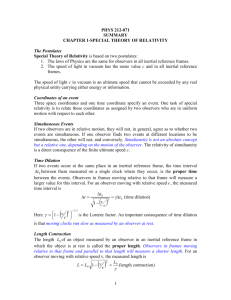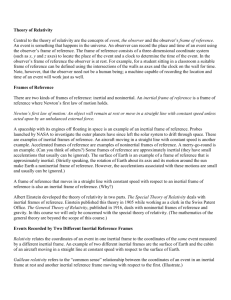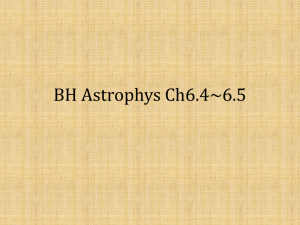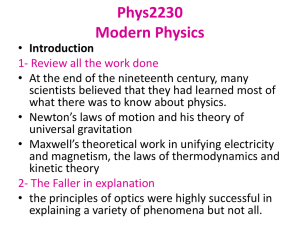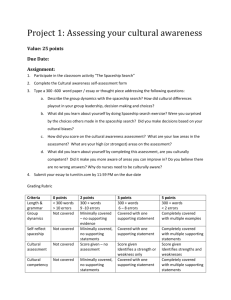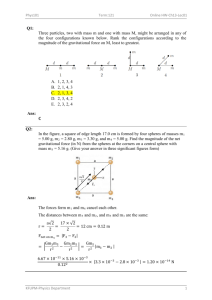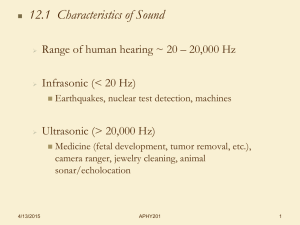Theory of Relativity
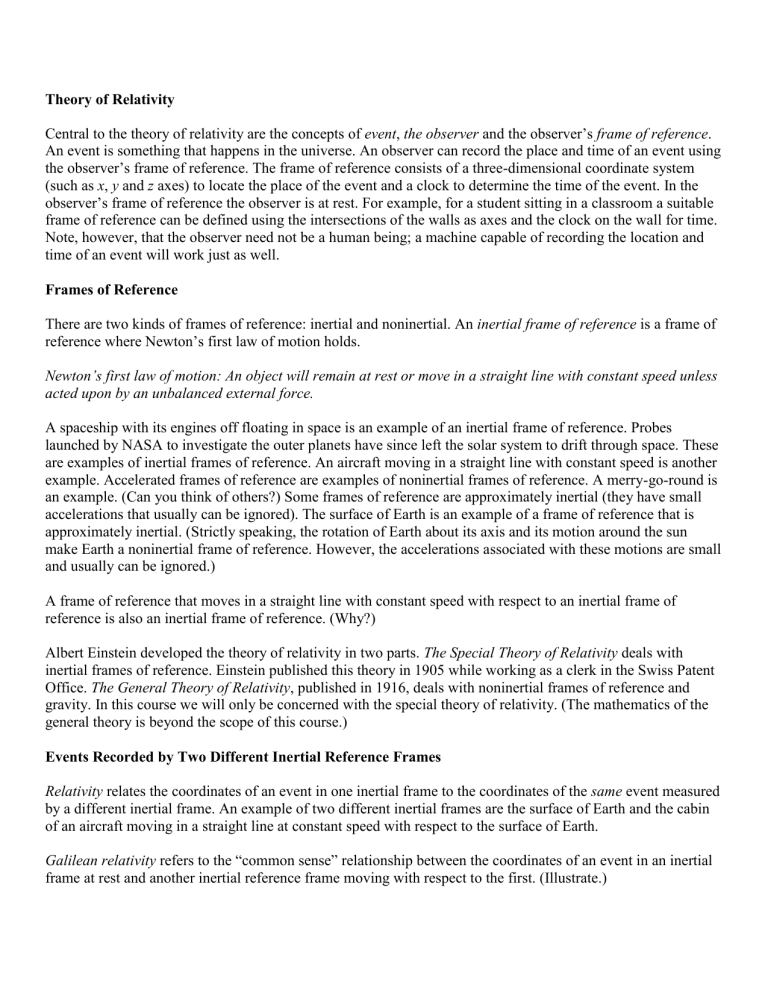
Theory of Relativity
Central to the theory of relativity are the concepts of event , the observer and the observer’s frame of reference .
An event is something that happens in the universe. An observer can record the place and time of an event using the observer’s frame of reference. The frame of reference consists of a three-dimensional coordinate system
(such as x , y and z axes) to locate the place of the event and a clock to determine the time of the event. In the observer’s frame of reference the observer is at rest. For example, for a student sitting in a classroom a suitable frame of reference can be defined using the intersections of the walls as axes and the clock on the wall for time.
Note, however, that the observer need not be a human being; a machine capable of recording the location and time of an event will work just as well.
Frames of Reference
There are two kinds of frames of reference: inertial and noninertial. An inertial frame of reference is a frame of reference where Newton’s first law of motion holds.
Newton’s first law of motion: An object will remain at rest or move in a straight line with constant speed unless acted upon by an unbalanced external force.
A spaceship with its engines off floating in space is an example of an inertial frame of reference. Probes launched by NASA to investigate the outer planets have since left the solar system to drift through space. These are examples of inertial frames of reference. An aircraft moving in a straight line with constant speed is another example. Accelerated frames of reference are examples of noninertial frames of reference. A merry-go-round is an example. (Can you think of others?) Some frames of reference are approximately inertial (they have small accelerations that usually can be ignored). The surface of Earth is an example of a frame of reference that is approximately inertial. (Strictly speaking, the rotation of Earth about its axis and its motion around the sun make Earth a noninertial frame of reference. However, the accelerations associated with these motions are small and usually can be ignored.)
A frame of reference that moves in a straight line with constant speed with respect to an inertial frame of reference is also an inertial frame of reference. (Why?)
Albert Einstein developed the theory of relativity in two parts. The Special Theory of Relativity deals with inertial frames of reference. Einstein published this theory in 1905 while working as a clerk in the Swiss Patent
Office. The General Theory of Relativity , published in 1916, deals with noninertial frames of reference and gravity. In this course we will only be concerned with the special theory of relativity. (The mathematics of the general theory is beyond the scope of this course.)
Events Recorded by Two Different Inertial Reference Frames
Relativity relates the coordinates of an event in one inertial frame to the coordinates of the same event measured by a different inertial frame. An example of two different inertial frames are the surface of Earth and the cabin of an aircraft moving in a straight line at constant speed with respect to the surface of Earth.
Galilean relativity refers to the “common sense” relationship between the coordinates of an event in an inertial frame at rest and another inertial reference frame moving with respect to the first. (Illustrate.)
Galilean Transformation
Assume that the moving frame moves along the + x axis with speed v and that the origins of the two frames meet at t = 0 seconds.
The Galilean transformation is x
vt , t
t where
and
v
Using the Galilean transformation it can be shown that all the laws of mechanics are the same in both frames of reference. (Give an example.)
There is a problem with the Galilean transformation when considering the laws of electromagnetism (i.e.,
Maxwell’s equations).
Consider the following. A jogger is running east along a straight road at 5 miles per hour. A car traveling east along the same road passes the jogger at a speed of 25 miles per hour. (This is the speed of the car relative to the road.) How fast is the car moving with respect to the jogger? (20 miles per hour.)
Galilean velocity transformation: u
v u
Now consider a spaceship traveling toward Alpha Centauri with a speed of 0.75
c (three-fourths the speed of light). (This is the speed of the spaceship relative to the star Alpha Centauri, which we consider to be at rest.) A light ray traveling toward Alpha Centauri passes the spaceship with speed c (the speed of light in vacuum).
According to Galilean relativity, how fast is the light ray traveling with respect to the spaceship? (0.25
c or onequarter the speed of light).
This last example poses a problem. The problem is that the speed of light , c
, is predicted by Maxwell’s equations to have one single value: c
1
0
. Maxwell’s equations flatly state that when you (YOU meaning
ANY observer) measure the speed of light, this is the value you get. So, according to Maxwell’s equations the observer in the spaceship also observes the light ray traveling with speed c . This is in direct contradiction to
Galilean relativity and appears to be complete nonsense. One alternative is to say that Maxwell’s equations do not apply to the moving spaceship and that there is one (and only one) preferred frame of reference (this was called the ether
) in which Maxwell’s equations are correct.
To determine the answer to a question like this scientists do experiments. All the experiments done to date (the most famous of these is the Michelson-Morley experiment) show that it is Maxwell who is correct; all observers measure c for the speed of light in a vacuum regardless of their relative motion! The problem is not with
Maxwell’s equations but with the Galilean transformation!
The Lorentz Transformation
The Dutch physicist H. A. Lorentz derived a set of equations that keeps the speed of light the same in all inertial frames of reference.
Lorentz transformation: x
x
vt
, t
t
vx c
2
1
v
2 c
2
(the y and z coordinates of an event are the same for both
1
v
2 c
2 frames of reference.)
We do not have time to discuss these in detail, but are given for your reference since they are not in your text.
You should note, however, that if v c , the Lorentz transformation becomes the Galilean transformation. For speeds much less than the speed of light the Galilean transformation works just fine.
Einstein laid the foundation of the special theory of relativity on two postulates and then showed that the
Lorentz transformation (and many other important results) follow logically from these postulates. We will look at these postulates and use them to predict some important results of the Lorentz transformation.
Einstein’s Postulates
In the following “speed of light” means the speed of electromagnetic waves in vacuum.
The Principle of Relativity.
The laws of physics are the same in all inertial frames of reference.
The Principle of the Constancy of the Speed of Light . The speed of light is the same in all inertial frames of reference.
One can show that the Lorentz transformation results from these postulates. A consequence of the Lorentz transformation is the addition theorem for velocities:
Relativistic velocity transformation u
u
v
1
uv c
2
Try this formula for the previous two examples.
We now turn to two interesting effects of relative motion.
Time Dilation
We assume that each observer is in an inertial frame of reference. The passage of time for a moving observer is slower than it is for an observer at rest. To see why this is so we first need to define proper time :
The proper time interval between two events is the time interval measured by an observer for which the events occur at the same place .
1 We denote the proper time interval by
t
0
. We denote by
t the time interval between the same events as measured by an observer for which the proper-time observer moves with speed v .
Consider a light clock constructed as follows: A laser, connected to an event counter, sends a pulse of light straight up to a mirror that is mounted at some known distance directly above the laser. The pulse reflects back down to the laser, where the event counter registers reception. The count of the counter represents the passage of a fixed amount of time, so this device can serve as a clock, with the returning pulse providing the “tick”.
Now consider a second light clock that moves to the right with speed v with respect to the first. The light pulse from the second light clock does not move up and down but along diagonal paths before it returns to the laser.
(See the figure below.) c
t
2 c
t
0
2 v
t
2
Light Clock
t
0
is the proper time between the emission of the light pulse and its reception at the laser in the frame where the light clock is at rest. This is proper time because the emission and reception of the pulse occur at the same place.
t is the time between the emission of the light pulse and its reception at the laser of the moving light clock. This is not proper time because the emission and reception occur at different places. The relation between these time intervals can be found using the Pythagorean theorem: c
2
t
2
4 t
2
1
c
2 v c
2
2
t
4
2
0
t
0
2 v
2
4 t
2
or t
2 t
0
2 v c
2
2
t
2 v c
2
2 t
from which
1
t
0
v c
2
2 t
0
2
. This is the time dilation formula.
(Note that t t
0
, hence the term "time dilation".)
1 Strictly speaking, at the same x -coordinate.
Length Contraction
When an object moves its length is shortened along the direction of motion. To see why this is so we first need to define proper length :
The proper length of an object is the length measured by an observer for which the object is at rest . We denote the proper length by L
0
. We denote by L the length of the same object as measured by an observer for which the proper-length observer moves with speed v .
Now let us see how L and L
0
are related. Let us consider as our “object” planet Earth and the star Alpha
Centauri, which we will consider to be at rest with respect to each other. The proper distance between Earth and the star is L
0
. Figure ( a ) above shows a spaceship traveling with speed v from Earth to the star. Relative to
Earth, it takes the spaceship a time
t to traverse the distance from Earth to the star. (Note that this is not a proper time interval because the event of the spaceship leaving Earth and the event of its arrival at Alpha
Centauri occur at different places.) We can write v
L
0
t
. Relative to an observer in the spaceship, the spaceship is at rest and it is Earth and the star that are moving with speed v . (See Figure b above.) Relative to the spaceship, Earth and the star move through a distance L in time
t
0
. (Note that this is a proper time interval because the event of Earth leaving the nose of the spaceship and the event of Alpha Centauri arriving at the nose of the spaceship occur at the same
L
0 t
L t
0
place.) We can write
or
L
0
L
t
t
0 v
L
t
0
. Hence
. But by the time dilation formula
t
t
0
1
1
v
2 c
2 hence
L
0
L
1
1
v
2 c
2
or L
L
0
1
v
2 c
2
Length contraction formula .
Example
A trip to the center of the galaxy .
1 light-year (c-yr) is the distance light travels in one year.
1 c-yr
8 m s
s hr
24 hr day
365 days
1 yr yr
15
1 c-yr 9.46 10 m
The distance from Earth to the center of the galaxy is L
0
= 33,000 c-yr. Suppose a spaceship leaves Earth and travels to the center of the galaxy at a speed so close to the speed of light that
1 v c
2
2
1
. (One can show that v
c
Since the speed of the spaceship is so close to that of light, relative to Earth it will take the spaceship 33,000 years to reach the center of the galaxy and another 33,000 years to return. Is it possible for the observer in the spaceship to live that long (66,000 years)?! In classical physics the answer would be no . But classical physics does not take into account length contraction as observed from the spaceship.
Recall from the derivation of the length contraction formula above that the observer in the spaceship sees the distance traveled ( L ) as smaller than the same distance as measured on Earth ( L
0
). The distance from Earth to the center of the galaxy, as reckoned by the observer on the spaceship, is given by:
L
L
0
1
v
2
; L
(33,000 c-yr) c
2
1
so L
1
365
c-yr
1
(What is c-yr?
365
L
1 c-day.
1
365
c-yr
1 c-day; 1 c-day
1 light-day.)
One light-day is the distance light travels in 1 day. Since the relative speed of the spaceship and the star is nearly the speed of light, the observer in the spaceship determines that only one day has elapsed between his departure from Earth and his arrival at the center of the galaxy ! On his return trip, assuming that he travels with the same speed, only one more day elapses ! The observer on the spaceship, after returning from his trip to the center of the galaxy, has aged by only two days! But upon returning home our spaceship traveler finds that Earth has aged by 66,000 years!
